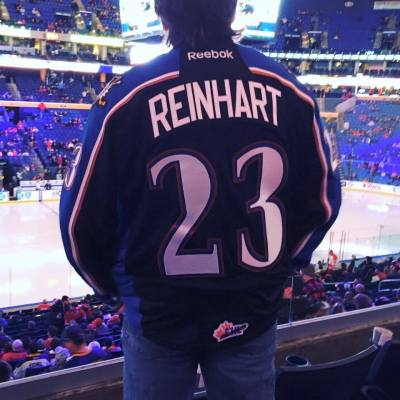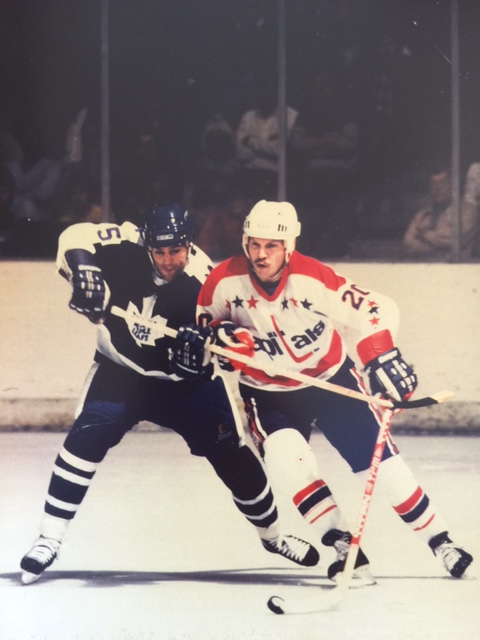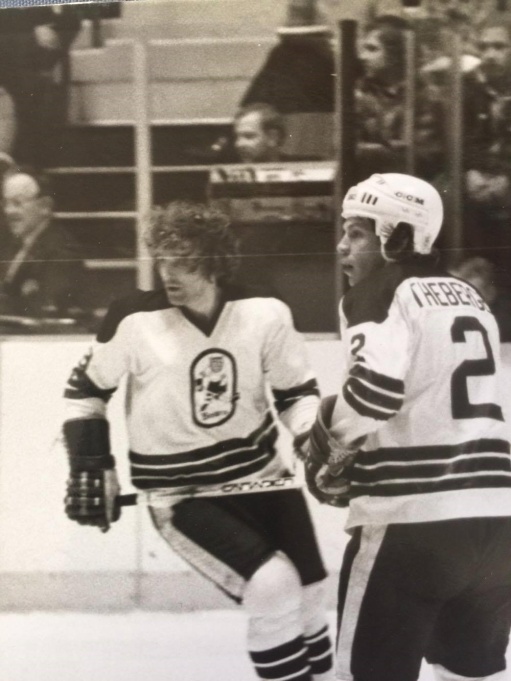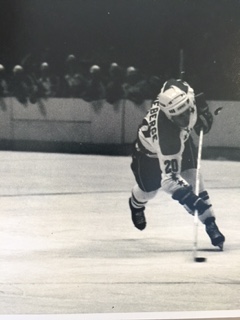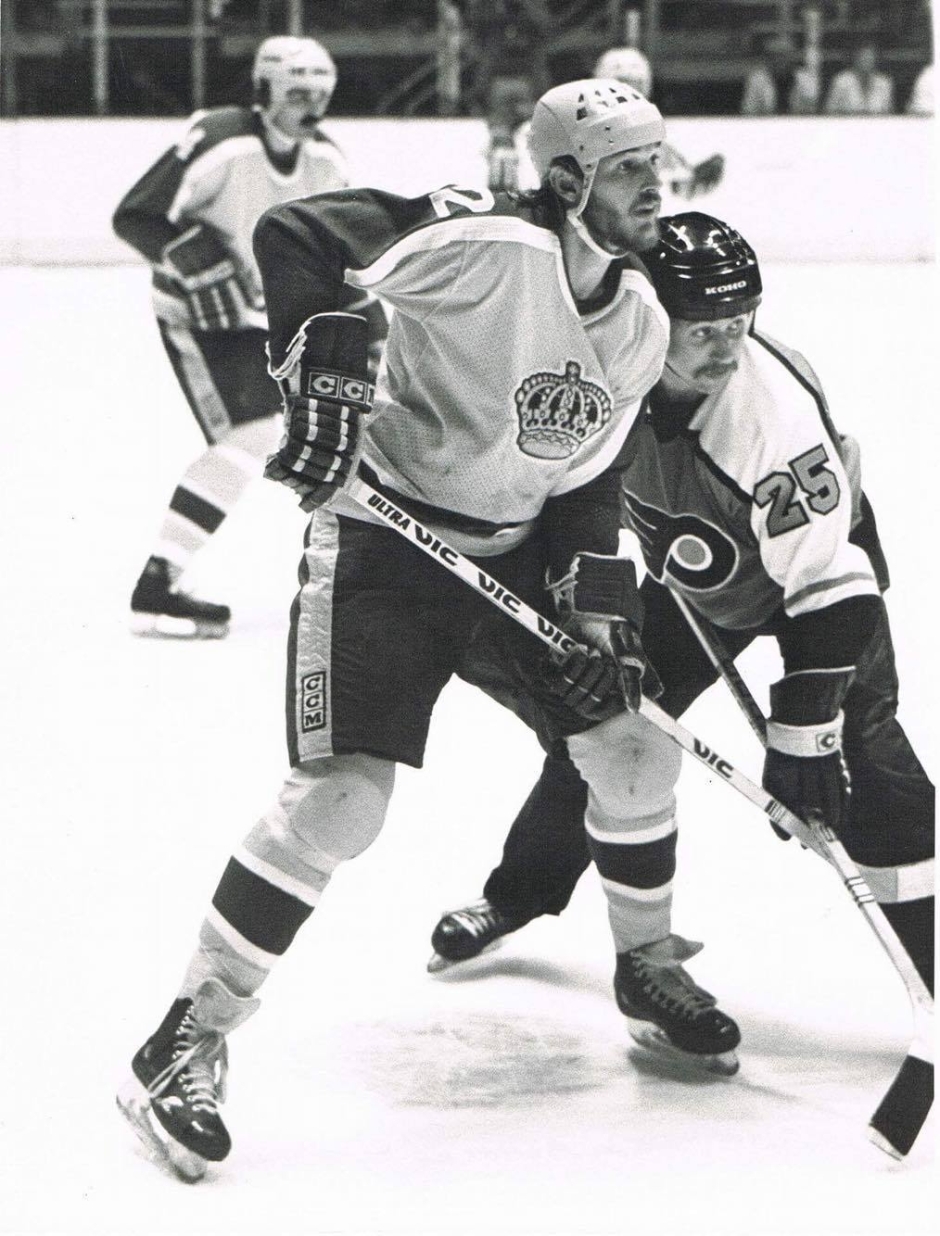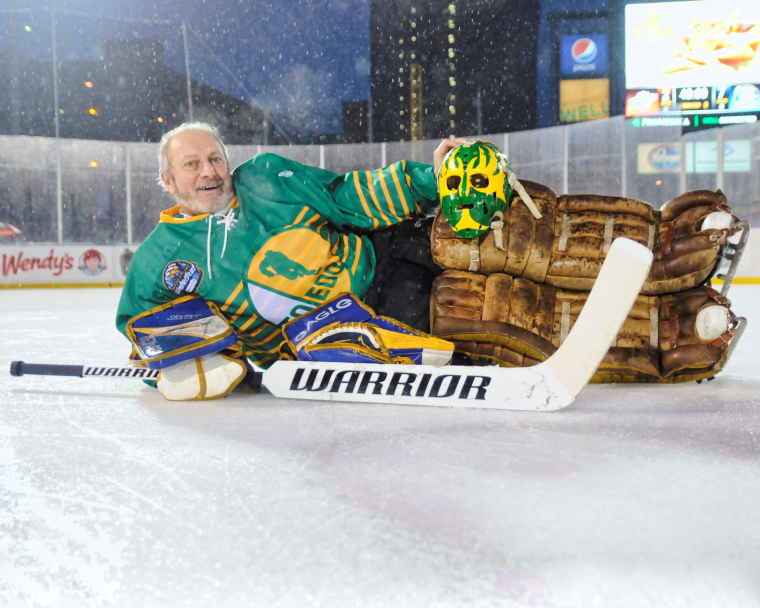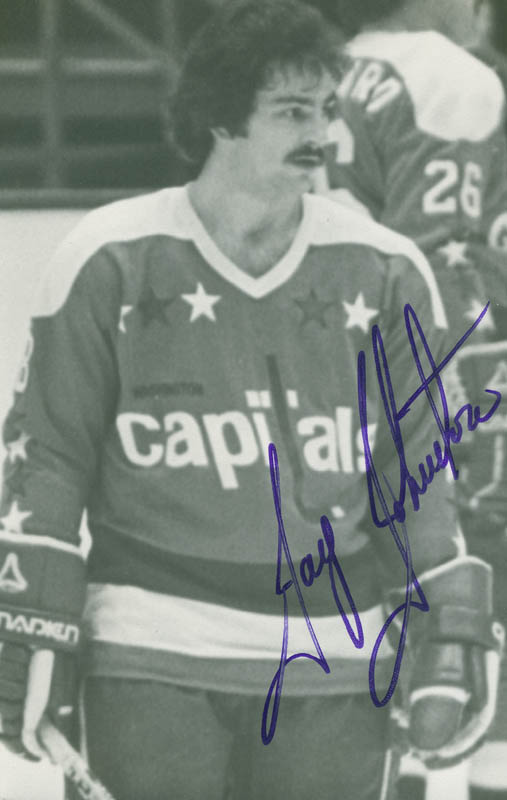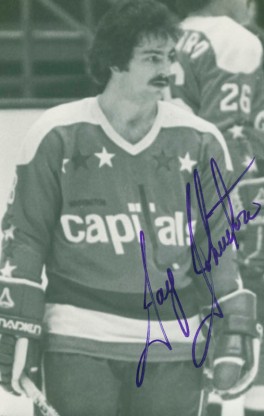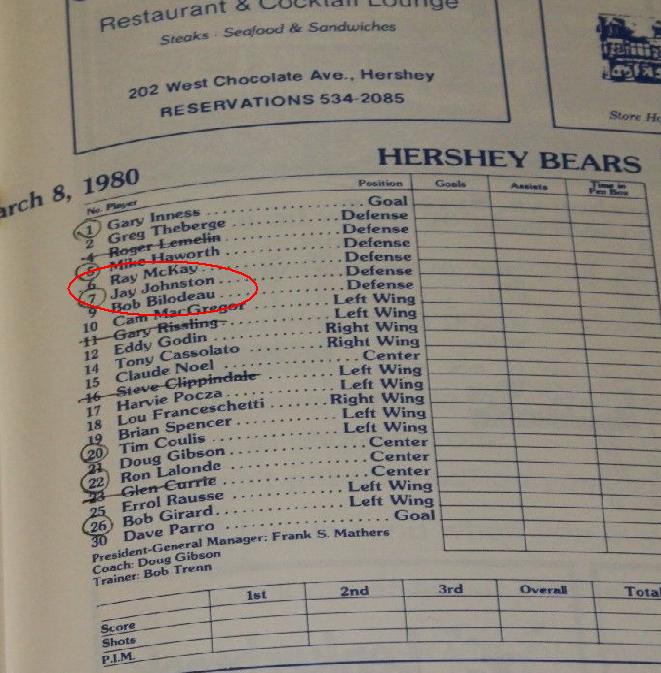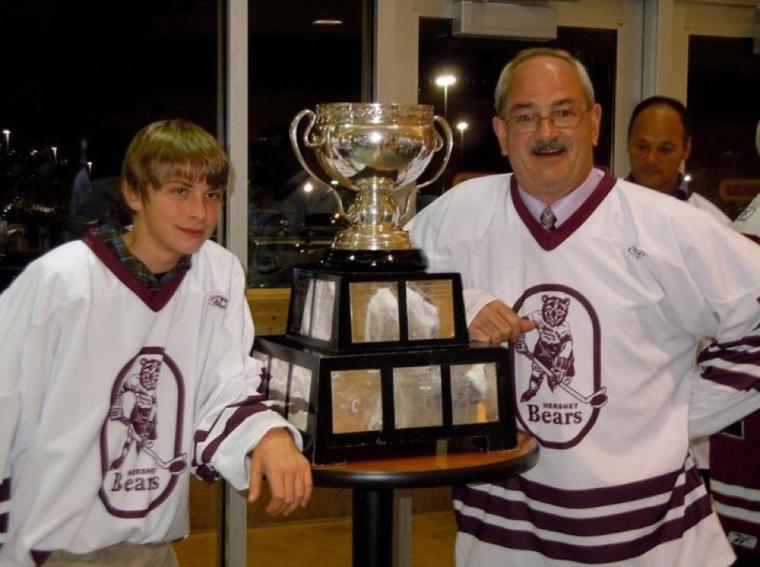
You can picture him clearly. A boy all of 11 or 12 years of age. The early 1970s. Expansion of teams in the National Hockey League had become somewhat of an epidemic at that time. And there was a rival league too. Huddled up in bed at night, a small AM radio in hand hidden under the covers to prevent his parents from hearing. Evening in the suburbs of Montreal no less, and a young Chris Langevin is listening to broadcasts of Buffalo Sabres’ hockey games. The frenzied trill of an orchestra as the Sabres’ introductory theme, Sabre Dance, leads them onto the ice, instantly invoking visions of their fabled “French Connection”-line soaring along the ice. Richard Martin, Rene Robert, and Langevin’s future teammate, the greatest Sabre of them all, Gilbert Perreault.
“I can still hear that song in my head. That rally song had something about it; almost hypnotic. It had a real impact on me. I’d be lying in bed at night as a kid listening to the Sabres game. Living in the suburbs of Montreal, I don’t even know how we got that radio broadcast, but we did. And that music… I’ll always remember the music of that song coming through my radio. For some reason, it really reached into me. Something that I have never forgotten, and every time I think of that song today it still can give me chills”.
It’s mid-October, and I am spending a rainy evening in Buffalo chatting with former Buffalo Sabres winger Chris Langevin. To say that Chris did his job as a hockey player is an understatement. In fact, it is so greatly understated that many are unaware of what this man accomplished in a relatively brief professional career. Chris himself downplays it to me, whereas I look at him in an almost a heroic light. But I feel compelled to remind him that the way he played the game of hockey truly meant something to other people. Whether it be the teammates that he protected, the odd but incredibly talented coaches he played for, or the fans of the game like me.
“I started skating when I was about 3 or 4-years old. My family and I lived in West Mount, a suburb of Montreal. Some of the memories that I’ll always have are skating in circles on an outdoor rink as child”, Langevin is saying, and I feel like I am right there with him as he looks back in his mind’s eye. “The rink was covered with a roof but it was totally open on the walls. I used to wear these Montreal Canadiens socks. They were probably a bit too large for me. I would be skating around in circles. I just loved to skate; always have. My parents would be watching me and laughing at me because the socks would start to fall down and you could see my long underwear underneath. I must have looked ridiculous”, he recalls with a hearty laugh.
While Langevin was always a Canadiens fan, it was those radio broadcasts and that entrancing Sabre Dance theme that really took hold of him during his younger years, leading him to falling in love with the game of hockey; a sport that was readily available to him in the province of Quebec. “It was pretty easy and obviously a really good thing for kids to play hockey. Organized hockey was always around, and the costs were included with the taxes that we paid, so there was really no cost other than the equipment we needed to play. I probably started playing organized hockey at the age of 10. We played about one game a week, and most of the games we played were played outdoors”. Perhaps stepping back into hockey’s roots, the simpler game of Langevin’s youth seems far more enjoyable to me. “Because most of the games were played outdoors, you know, we would have to shovel the ice and all. It certainly wasn’t the same as the game is today. It was a just a bunch of us kids playing. It was hilarious sometimes too – I remember playing some games in the rain. I lived fairly close to the rink, so sometimes when it was raining I would be walking to the rink only to find that we weren’t playing because of the weather, and you would just be devastated because you were really lucky if you played even two times a week”. Born November 27th, 1959, the proximity of Langevin to hockey’s most storied franchise, the Montreal Canadiens, provided some early thrills. “I remember getting to see Jean Beliveau score his 500th career goal. And I actually had the opportunity to meet him multiple times.
The more that Chris Langevin skated and played, the better he became. And though that was the case as he progressed through all levels of the game, as a teenager the Chicoutimi Sagueneens of the Quebec Major Junior Hockey League took note of the young lad. From here, Langevin’s place in the game would forever change. “I was one of the last draft picks taken during my draft year for junior. I remember thinking, ‘Chicoutimi? Where the hell is that?!’. But to me though, it was my dream. I was never a good skater, and so I had never thought or envisioned getting that far”.
In Chicoutimi, Chris had to contend with one of hockey’s oddest coaches of all time in Orval Tessier. “Orval was the strangest coach that I ever played for. He’s the same guy that when he coached the Chicago Blackhawks made that infamous quote about his players needing heart transplants after the team had lost during the playoffs. He never really helped you learn anything. I remember going to him sometimes and saying to him, ‘I have been working on this play, what do you think?’ or ‘what do you feel about this in my training to help me be a better player?’, and he’d just say ‘I don’t care’ and walk away. It was really bizarre”. As Chris and I talk, we agree that he played for a natural hat trick of coaches who marched to the beat of their own drum; Tessier, Mike Keenan and Scotty Bowman. “With the other two coaches, (Keenan and Bowman) they were much different in their own way but were obviously incredibly successful. Tessier on the other hand was just plain weird. After he made that ‘heart transplant’ comment, I don’t know how much more coaching he did after that”.

The star player for the Sagueneens during Langevin’s time was a future 3-time Stanley Cup winner Guy Carbonneau. Langevin and Carbonneau were teammates in Chicoutimi for three years, and during that stretch Carbonneau finished in the top ten in scoring for the QMJHL, including the second overall scorer his final year in major junior. Carbonneau would need a protector out on the ice, and Langevin fit the bill quite well. “Guy was certainly an offensive force, eh?”, Chris asks me. “I had always been a goal scorer, myself. But I went to camp, and ended up playing with Carbonneau on a line. I would stick up for guys like him. I would drop the gloves, and I actually did very well at it. But it was very different for me. It was my job to protect Guy, but at the same time I went away from being a goal scorer; I protected a player like him. But it is also funny how things work out too. I transitioned from being a goal scorer to being a protector, and then Guy later in his career went from being a scorer to one of the best defensive specialists to play the game”.
While Carbonneau would explode for seasons of 141 and 182-points his last two years of major junior, Langevin would put up solid numbers of his own, including two straight 20-plus goal seasons and a final season with the Sagueneens that saw him score better than a point per game (22-goals and 30-assists for 52-points in only 46-games). Besides Carbonneau, many of Langevin’s Chicoutimi teammates would go onto careers in the NHL. Gilles Hamel, a teammate of Langevin’s during his final year of major junior, would eventually end up being alongside him with two more teams, the Sabres and the Rochester Americans, later on in their careers, while other Sagueneens players Gilbert Delorme, Alan Haworth, Gord Donnelly, Sam St. Laurent, Louis Sleigher, and “Super Mario’s” older brother, Alain Lemieux, would all spend time in the NHL. “I’d have to say from my time in Chicoutimi, a good 10-12 players went on to spend at least some time in the NHL”, Chris recalls.
Despite a new found role and top-notch teammates whom he protected, Langevin never thought of his career going much further than playing major junior. In fact, he would not even be drafted into the league by an NHL team. “I honestly thought that I wouldn’t be playing hockey anymore. But I ended up getting invited to a camp in Saginaw (the Gears of the IHL). I had always been an aggressive player, but I could still score. I did a lot of hitting, was good in the corners, and I was always protecting the better players. I felt that I was complimentary to the skilled guys. But I ended up walking into the dressing room in Saginaw, and I immediately thought to myself, ‘Are you friggin’ kidding me? This is a joke! It was like Slap-Shot 2‘. Even though I played a physical game, I was not necessarily a big guy at 6-foot and close to 200lbs. I looked around, and there are all these huge guys who were really not good hockey players”.
Elaborating more on that thought, Chris explains that “the IHL really needed to have a certain amount of rookies to qualify as a minor development league. The IHL could probably be equated to today’s ECHL; a AA level of hockey. Going in, it was actually scary to see all of these goons. You think to yourself, ‘I just wanna go home’. I wasn’t the biggest guy, so I was an easy target. I honestly thought, ‘I swear to God, this is Charlestown! This is the Charlestown Chiefs from Slap-Shot!”. But Langevin stuck it out and stayed in Saginaw for the 1980-81 season. He would finish fourth overall in team scoring with 35-goals and 48-assists, and would become a champion in only his first season of professional hockey.
Winning the IHL’s Turner Cup championship was “Amazing!”, as Chris describes it. “I remember early on in that season I was a bit intimidated by the size of the players around me. We were playing a game and there was this huge guy who had the puck behind the net. I came around and absolutely smoked him behind the net; just smoked him. Well, he got up and ended up chasing me down the ice, so I knew I had to stand up for myself – if I didn’t at that point, it would’ve been over with most likely. So I turned around and dropped the gloves, and ended up proving myself to the league and to my teammates”.
As he had protected players in Chicoutimi, Chris Langevin found himself in the role of the protector once again. The top scorer in the IHL that season was Saginaw’s own Marcel Comeau; a shifty, but smaller centerman who at 6-foot only weighed 165lbs. Comeau led the league in points with 126 and in assists with 82 of them. It was Langevin’s job to protect Comeau now. “I was put on the first line with Marcel Comeau. He would feed me the puck, and I put together my best offensive numbers of my career at the pro level. I played the game bigger than what I was. Looking back that was wrong in some ways because it led to a lot of injuries, but it was what also got me to the NHL. I had always wanted to be a scorer, and at least in Saginaw I was able to do that too, but I also had a role to play. It also depends on the timing that you get with a team and what their needs are. I was never a goon; always played on the top lines. But I was sort of condemned because I was good at dropping the gloves. In the IHL, everyone was really out for themselves because we were all fighting for jobs. But after the CHL’s Houston Apollos folded we ended up getting some of their players like John Gibson and Scott Gruhl, and we became a really good hockey team. We held together, and ended up winning that championship”.

After the championship run in Saginaw, Chris ended up getting a first time opportunity to make an NHL club, and he ended up advancing at least to the next closest level. “After that season in Saginaw when we won the cup, I had an agent and I got invited to a tryout camp in Buffalo. I didn’t make the Sabres but I did receive a contract and signed with Buffalo’s American Hockey League affiliate the Rochester Americans. I went from making a yearly salary of $7,500 with Saginaw to making $20,000 with Rochester – I was elated!”. For Langevin’s first two seasons in Rochester he would play under the watchful eye of “Iron Mike” Keenan and would be reunited with former Chicoutimi teammates Gilles Hamel and Alan Haworth as well. Rochester’s hockey club during the early 1980s was incredibly talented to say the least, and could have rivaled numerous NHL clubs of that time too. It would not take long for Langevin and team to find success and demonstrate how solid of a hockey team they were.
“It was amazing. Even if I had not made it to the NHL, I was pretty happy where I was with Rochester. You did learn from older guys who were there like Yvon Lambert, Phil Myre; older guys like that who had been around and were trying to extend their careers. There were a lot of French-Canadian guys on our team. And we all wanted to win so badly and find success that we used to have fights in practice even. I’m not kidding you. There would be fights during practice between the French and the English-speaking players. Everyone was just so intense. We would have our practices in Lake Shore right along Lake Erie, and that rink would be so cold – like 20-below; you would just freeze. Guys would shoot pucks in there at other guys’ ankles. It wasn’t done to be malicious. We were all just competing with one another to get to the next level. The guys on the team from the west were bigger and stronger, while the Quebec guys were smaller and more talented. I was stuck in the middle, having to protect who I could”, Langevin recalls with laughter and mild incredulity over the situation.
As he had done with Guy Carbonneau and Marcel Comeau previously, Langevin now protected Rochester’s top scorer, Geordie Robertson. “He was the guy that I played with the most. I still think he is one of the highest scorers in Amerks’ history. I was his protector. Geordie had influence with the coaches as a seasoned veteran, and he certainly had a role with me playing with him. He’d go and antagonize other players, and then I’d jump in to do my job”. One of the greatest seasons in Amerks history, 1982-83, saw Robertson lead all Rochester players in scoring with 46-goals and 73-assists for 119-points; good enough for third overall in the league, while his protector Langevin led the team in penalty minutes with 255 and finished sixth overall in the league for that category. Speaking further on his teammates: “all of the French guys on the team were very close and incredibly talented. Guys like Gilles Hamel, Jean-Francois Sauve, Bob Mongrain, Jacques Cloutier. They all went on to solid careers in the NHL”.
And then there was Keenan. The 1984-85 Jack Adams Award winner as the NHL’s coach of the year, Mike Keenan would eventually win the Stanley Cup in 1994 with the New York Rangers and had three other Stanley Cup Finals appearances. But it was his extremely tough coaching style and the general attitude he had towards his players that earned him the nickname “Iron Mike”. Keenan was renowned for messing with the heads of his players and some of his tactics in doing so have been widely questioned. But what cannot be questioned is the results he achieved, and what would culminate into a Calder Cup championship for himself, Langevin and the Amerks for the 1982-83 season.
“Mike Keenan – playing for him was great. For me, it was absolutely great. He was very demanding, but I had zero issues playing for him. I personally don’t think he is given enough credit for his coaching abilities. He created drills in practices that no one knew what the hell he was trying to teach us. I think a big part of it was to keep players focused and on their toes. He was incredibly innovative; just very ahead of his time. Keenan was just so intense, and he would lose it with the most talented players. He really singled out players who were not playing up to their potential, or for a lack of effort. But he did so to make them better players and help them move onto the NHL, his primary mandate. I really have nothing but good things to say about him. I did find him a bit strange as he moved on throughout his time in the NHL. In my opinion, he was the best coach that I ever played for”.
Winning the Calder Cup with Rochester, his second championship in only three years of playing professionally, and eventually earning the captaincy in Rochester was proof enough that Langevin had found solid ground in his own game. “I always kept trying to get to the 20-goal mark. I always thought that I was capable of doing that, and it was a goal to do that in the NHL, to go along with 200-penalty minutes too. It was really something that I worked toward and felt that it was a reasonable objective”.

The Buffalo Sabres took note of Langevin’s determination and almost reckless abandonment for himself in order to get the job done and win hockey games. Going through an “injury bug” of their own, Buffalo brought Langevin up on an emergency recall to join them. “I drove from Rochester to Buffalo, which is about an hour and 15 to an hour and 30-minute drive, and then immediately hopped onto a bus with the team to ride up for a game in Toronto. I’m not flying – I’m busing it! In my first NHL game!”, Langevin laughs heartily at this memory, realizing that he spent all this time riding buses in the minors, and then for his first NHL game he ends up riding a bus once more. “After the game in Toronto though, we would fly to Detroit and then to Boston as well”.
Langevin would remain with the Sabres for a 6-game stretch and would even score his first NHL goal. Dreams were indeed coming true. “I honestly feel that I played the best hockey of my career during those 6-games. I think the biggest thing that hurt me was that I wasn’t actually drafted by Buffalo. During those games the other players on the left side were Craig Ramsay, Paul Cyr and Dave Andreychuk, and I felt that I outplayed at least two of those guys. I was playing nearly 20-minutes a game too, on a line with Sean McKenna and Gilles Hamel. But I hadn’t been picked by the Sabres, and I only had one goal during that stretch, so I think it was easier for them to send me back down once the injured players returned. Drafted players have a longer leash and always seemed to get the second chances, which is perfectly understandable”.
The goal would come against the Boston Bruins and goaltender Pete Peeters during Langevin’s third of the six games. It was a beauty too. “We were losing to Boston 4-0 or something like that. Sean McKenna was skating behind the net. He threw it out front to me in the slot and I just blasted it right by Peeters; he didn’t even see it. And you want your first goal to be like that. Not a fluke or bouncing off a skate or stick. Just a clean shot right by the goalie. And on the very next shift I had an open net again and I just missed putting it in past Peters. Just think that if I could have put that one in too that game could have had a different outcome”.
But arguably the more quintessential moment for Chris during his callup, the one that really brought everything home for him and come full circle, was being up close and personal with the greatest Sabre of them all, Gilbert Perreault. “After getting the call for the game against Toronto, we flew to Detroit to play the Red Wings. And guess who I end up rooming with on the road? Gilbert Perreault! We’re in the same room together. I was just in awe. Really more like shock, actually. I sat down on my bed, and he just immediately starts talking with me. Just talking, talking and talking. I guess they could not find anybody who wanted to room with him because Gilbert really liked to talk and was not a fan of the ritual pregame nap. I usually liked to take a nap before a game, but I didn’t sleep before that one and it did not bother me at all. But Gilbert was just a true gentleman. Needless to say that song (Sabre Dance) came back into my head again, here I am chatting in the same room as Gilbert Perreault”.
After those six games Langevin was sent back down to Rochester. “It was really a big letdown when I got sent back down, but I understood the math behind it and what was going on behind the scenes. I knew that I was playing better than some of the other players at my position, but you are given more of a chance if you are a draft pick versus someone who isn’t, like me. But the one thing that I realized about myself was that I was getting better as a player as I was going forward. I had improved to the point that I knew I could play and skate in the NHL”.
1984-85 saw Chris have another solid season offensively and in penalty minutes with the Amerks. He set his career high in goals scored with Rochester, 19, and did so in just 63-games all the while putting up 212-penality minutes. But what would perhaps be more important for the future, Langevin’s coach for part of the season in Rochester was former Sabres great Jim Schoenfeld. The time spent with Schoenfeld would help to garner Langevin some insight into where his career was going. “I always felt that I could play for the Sabres on the left hand side. Jim Schoenfeld had coached me in Rochester during the ’84-’85 season before he got asked to suit up again as a player on defense in Buffalo because the Sabres had injuries on their blueline”.
Going into the 1985-86 campaign, “I knew that I was going to make the team that year”, Langevin recalls. “And once you get in, it’s hard to get out. I had been the captain for Schoenfeld in Rochester before he got called up to Buffalo to play. At the end of that season, I gave him a call because I knew he was going to be the coach in Buffalo (for the ’85-’86 season). I called him that summer and asked him, ‘will you give me a chance?’. He asked me back, ‘will you come into camp in the best shape of your life and play the exact same way as you did in Rochester?’. And I did exactly that – I worked out all summer really intensely and came into camp in the best shape of my life, and I stuck”. Unfairly, 16-games into the season Langevin blew-out his knee in a game against the Quebec Nordiques, and his career was over. Chris never played a professional hockey game after that.
“I earned every ounce of what I accomplished”, he tells me. And hell, he is exactly right. He did it all and fought for it all. Nothing was handed to him. “I had a good run. It was a really cool time, but I have no regrets. The two best days in my life were one, getting to stay in a room with Gilbert Perreault, and two, when Buffalo said to me that I should go ahead and find an apartment”. Other things would end that year too, as Jim Schoenfeld would be fired by the Sabres partway through that season as the team finished exactly at .500 and failed to make the playoffs. It would also be Gilbert Perreault’s final full season in the league, as he would retire after one more year of just 20-games. Scotty Bowman’s last full season with the Sabres would be that year too before he was let go early the following year, right around the time that Perreault officially retired.
Chris Langevin has gone onto work for Bauer hockey for 21-years. 70-percent of the equipment in the NHL today comes from Bauer. Chris has worked as a developer for them throughout that time, and has found great meaning in seeing some of his life’s work in action. His career though in hockey was shaped from everything he dreamed about from a very young age.
“I just dreamed of playing in the NHL. Hearing that Sabres song in my head, wearing my Montreal Canadiens socks and embarrassing myself as a kid on the ice. It was all that I ever wanted to do. It was my number one goal. You have to dream of something in order to accomplish something. Having courage, fortitude, a lot perseverance. With all of that, it is pretty hard to take away a dream. I had a dream, and I just never quit”.
Chris and I debate a bit back and forth as to what it means to be a hero. Perhaps I am mistaken when I tell him that someone like me thinks of him as a hero for having made it to the NHL like he did. Not having been drafted. Having to change his role from what he always wanted to be on the ice to what he was required to be. No matter how he did it, he made it. Chris disagrees with me. “Come on, we’re not heroes. Playing hockey is not what constitutes a hero”. I respond, “Okay, let me better explain myself. Maybe hero is the wrong word. But you have to realize though that what you did on the ice matters to people for whatever reason. We find some value or importance in what you accomplished”. He responds, “Okay, that’s a fair analysis. When I was captain for Rochester I used to do a lot of visits at hospitals for sick children and with charities and it seemed to make a difference for people. That to me is something that stands out”.
Exactly. And because you are one of those few people who had a dream and never stopped working for it, eventually accomplishing it – that sets an example in and of itself for anyone who takes the time to listen. So yes, people like me look up to people like you. It means something. And you earned every bit of it.
